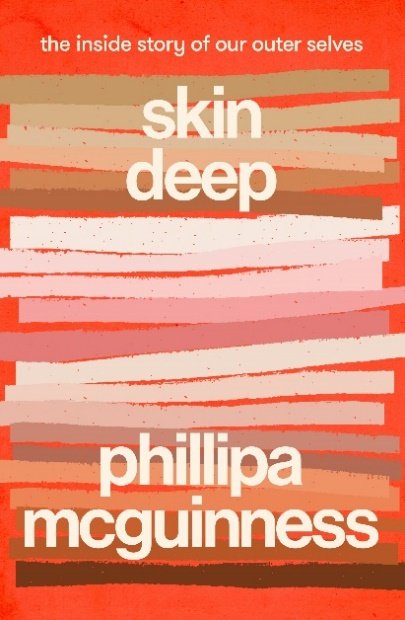‘Your skin remembers everything’
I’m standing in my underwear on the 20th floor of a suburban office tower, arms outstretched. Midday sun streams through the north-facing window. Fluorescent light falls from panels in the ceiling. Sharper light beams towards me. My skin, looking paler than ever under all this brightness, is getting a thorough going-over. Every square inch of epidermis. The soles of my feet. The webbing between my toes. My palms. The contours of my ears. My scalp, armpits, limbs, torso, back, eyelids and nose. My decolletage and backside. The surroundings are familiar and my visit routine, but the truth is I feel a tight-chested, dry-mouthed sense of dread, every time. We chat as I undress, but [my dermatologist] Dr Ming goes quiet as he puts on his special glasses to begin the examination.
Dr Ming may freeze something off with liquid nitrogen. He will almost certainly annotate my chart, laid out on his desk for easy reference, which shows a constellation of dots and dates speckled across an outline of the human body. My body. If this map had a legend, its symbols would denote moles, freckles, lesions, papules, pigmentation, bumps and scars. Its title could be “Typical skin of >50 y/o Australian settler, colonist (orig. Irish/Scottish)”.
This sorry document charts two things: the landscape of my epidermis, and time. Almost 10 per cent of all spending in the Australian health system covers consultations to do with non-melanoma skin cancers. These include basal cell carcinomas (BCCs), which is what Dr Ming is most likely to find on me. I’ve discovered these non-invasive growths – the world’s most common cancer – on my face myself. They also go by another disgusting name: rodent ulcers.
Dermatologists describe BCCs as small bumps, red scaly spots that don’t go away, or pearly lumps. These criteria seem reasonable until you identify quite a few pearly lumps on your skin. Surely, you panic, they can’t all be BCCs. Basal cell carcinomas are caused by sun exposure that triggers a mutation in the DNA of one of the skin’s basal cells. The Australasian College of Dermatologists website says that BCCs are most common in people with a Celtic background. Snap! It’s me. Any shade of skin can develop skin cancers, particularly melanoma, but the level of risk about how your DNA might be “sliced” or “tattooed” by sun exposure varies, depending in part on how “melanated” you are.
I’m in my early 50s and have had five BCCs cut out over the past 20 years. Once you’ve had four, your chances of developing more stand at 90 per cent, so it’s a safe bet they won’t be my last. That is depressing, but I’m in good company. I came to enjoy the awkward hokey-pokey dance my fellow fair-skinned Australians launched into when I told them I was writing about skin cancer. Twisting and stretching, they pointed to one they had on this side, one they had on that side, another over here, that one under there.
“A lot of people don’t realise that BCCs are even cancers,” says Dr Ming. “I’ll see people for the first time and ask, ‘So, have you had any skin cancers?’ and they’ll say, ‘No, I haven’t, Doc.’ ” And I’ll look through the notes and say, “Oh, but you’ve had basal cells,” and they’ll reply, “Oh, but I was told they were fine.”’
““As I was writing this book, an squamous cell carcinoma popped up on my leg. But they are curable … The worst-case scenario in this [dermatologist’s] room would be hearing the M-word.””
Dr Ming has to explain to complacent patients that such a prognosis may be technically true, “But they are still cancers. Because they grew. It’s a benign cancer, so to speak, because it doesn’t get into your bloodstream … so it’s more of a nuisance.”
Squamous cell carcinomas (SCCs) score higher on the index of concern. They’re messier and can metastasise, spreading into lymph nodes if left to their own devices. Right on cue, as I was in the middle of writing this book, an SCC popped up on my leg. (My body turning itself into a real-time case study makes good material but fed my anxiety no end.) This one was a squamous cell carcinoma in situ, which is also known as Bowen’s disease. But they too are curable, the treatment most of the time, again, being excision.
The worst-case scenario in this room would be hearing the M-word. Melanoma can kill. The most aggressive form of skin cancer, it forms in melanocytes, the skin’s pigment-producing cells. Melanoma is Australia’s national cancer. Along with Aotearoa New Zealand, we have a rate of melanoma incidence two to three times that of Canada, the United States or Britain. We have almost 12 times the worldwide average rate of melanoma.
In Australia, one in 14 men and one in 22 women will develop invasive melanoma in their lifetime. It is now the third-most common malignancy in Australia, behind colorectal, breast and prostate cancer. Incidence of the disease is rising steadily at 3 to 4 per cent each year, although for people under 40 melanoma is decreasing, a happy statistic.
Once or twice over the years I’ve caught myself proclaiming to Dr Ming, all rueful and wistful, “I was born in the wrong country.” Quoting another skin cancer–speckled patient, who said, “I guess I’m a white man in a Black man’s country,” Dr Ming tells me that technically, I’m exactly right.
……….
I gaze out the window towards Bondi Beach as I get dressed. I’ve swum in that sparkling sweep of Pacific Ocean for my whole life. It’s why I’m here. Diving into the surf on a sunny day, light and water spritzing over my body, made lighter, free. Swimming in currents of light as much as cool water. Plunging down to touch the sand under a wave, ascending into a rush of sunlight. Pure joy.
Sydney’s glorious coastline unmasks my disingenuousness. I don’t really think I was born in the wrong country. Is it an abrogation of responsibility to imply that whatever Dr Ming might find, it’s not my fault? Not my fault that I inherited the white skin of my ancestors, unpigmented by rainy, cool climes with gentle sunlight. Like a self-pitying teenager, am I whining that I didn’t choose to be descended from pale settlers who colonised a ferociously sunny distant land? Not my fault that I grew up in a beachside suburb before the Slip! Slop! Slap! public health mantra transformed our behaviour.
How was I to know that your skin remembers everything? When you were a teenager playing tennis for hours on a court without a shade-giving tree in sight, sweating off the sunscreen you forgot to reapply? Your skin remembers. That time you were 10 and a friend’s father took you to the beach where you swam for hours, sizzling, protected by nothing but a smear of zinc cream on your nose? Your skin remembers.
The fairness of my skin may cost the health system money, the excision of cancerous cells may cause me discomfort and I must never step out of my house without slathering SPF50 over my exposed skin. But I grew up in a land and a time where white people proudly displayed their post-sunburn peel. Wore as little as possible to expose as much bare skin as was legal. Applied fake tan while working on acquiring the real thing.
But now we live in the flipside of sunny paradise. We walk around with Steri-Strips holding our biopsied skin in place. Bits are chopped out of us, our bodies scarred and maimed. Our faces look wrinkled and weathered, older than they really are, thanks to excessive sun exposure. We spend our lives sitting in waiting rooms for appointments to get things on our skin checked out, burnt off, cut out, sewn up. Our treatment regimens will last a lifetime.
I fit right in.
This is an edited extract from Skin Deep by Phillipa McGuinness, $34.99, published by Vintage Australia.


